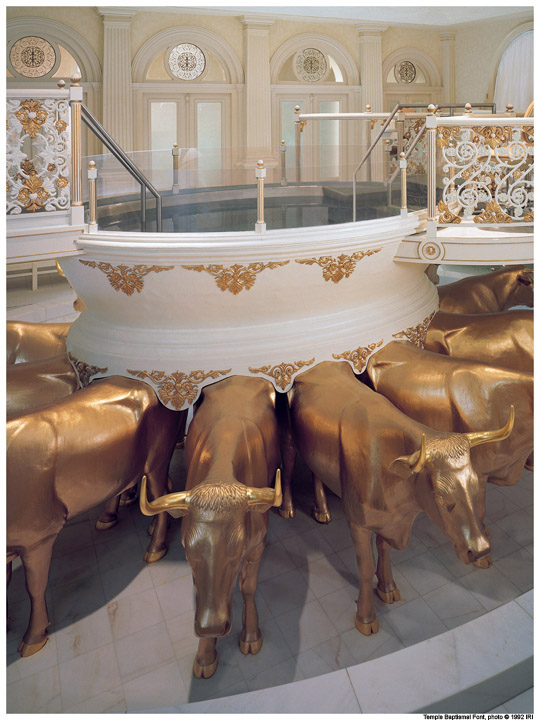 On 14 December 2017, a new directive from the First Presidency was released outlining changes to certain things related to youth performing baptisms for the dead in LDS temples, as well as to the annual meeting held to prepare 11-year-old boys to receive the priesthood in the coming calendar year. The changes primarily involve now allowing Priests in the Aaronic Priesthood (typically ages 16 to 18) to perform these baptisms, as well as to serve as official witnesses to them (tasks previously performed in temples only by Melchizedek Priesthood temple recommend holders), and also to have members of the Young Women’s program now take on baptistry roles that up until now have been performed only by female (adult) temple workers. The “Priesthood Preview” meeting is now being re-named the “Temple and Priesthood Preparation” meeting, and will now include 11-year-olds of both sexes, along with their parents (who already attended with their young men about to turn 12).
On 14 December 2017, a new directive from the First Presidency was released outlining changes to certain things related to youth performing baptisms for the dead in LDS temples, as well as to the annual meeting held to prepare 11-year-old boys to receive the priesthood in the coming calendar year. The changes primarily involve now allowing Priests in the Aaronic Priesthood (typically ages 16 to 18) to perform these baptisms, as well as to serve as official witnesses to them (tasks previously performed in temples only by Melchizedek Priesthood temple recommend holders), and also to have members of the Young Women’s program now take on baptistry roles that up until now have been performed only by female (adult) temple workers. The “Priesthood Preview” meeting is now being re-named the “Temple and Priesthood Preparation” meeting, and will now include 11-year-olds of both sexes, along with their parents (who already attended with their young men about to turn 12).
In this two-part episode, we focus on initial reactions to the announcements. Why might these have come? And why now? What are the nature of the roles that these youth will now be able to perform? How do temple baptistries work now, and how might this change? Is this announcement an overall positive step for the church in terms of moving toward greater equality of women and men, or does is actually highlight even more the inequalities between the sexes and their roles in the church? Will young women and men, especially those who know each other well (fellow ward members, etc.) be able to be comfortable in these new roles when it comes to performing the ordinances and temple work? Will the intimacy of ritual and touching (even in such non-sexual ways like what is involved in baptism) make them, especially the young women, uncomfortable? And/Or might this stir feelings in either the young men or women that are something other than “sacred” in nature (at least in the temple setting)? We discuss all of the above, and more!
Our guides for this “initial reactions” podcast episode are the incredible Cynthia Winward, Bruce Van Orden, Kent Nuttall, and Rosalynde Welch. Each is wise, insightful, and experienced in the various aspects and issues at play regarding the changes in both main areas here: the temple baptistry and working with Young Women, Young Men, and Primary-age children. They each contribute wonderfully!
Please listen and then join in with your comments below!


Comments 2
I personally hope most wards will generally have the priests baptize the ym and adults baptize the yw, or at least that the yw will be privately consulted with beforehand to make sure they’re comfortable. It’s a tricky dynamic.
Author
A poem that relates to many of the things shared in this podcast. I have remembered it through the years with fondness, as it speaks to this issue of confused feelings of spirituality and high ideals immediately alongside hormones and sexual attraction in even a sacred experience like baptism. I’ve appreciated the past few days of discussion in helping to raise in important ways aspects of this new policy about temple baptisms, especially when it comes to young people baptizing each other, modesty concerns, and confusion/possible shame were the mixture talked about here enter into some of the youth’s thoughts. I’m still fond of the poem as it highlights this tension, but thanks to these discussions, I now react to what it reveals with greater soberness. I hope you’ll enjoy reading it!
IMMERSION
Mikal Lofgren
Beside the swimming pool’s glancing
reflections Brad waits while
his companion and Birgitta dress
in white. The moist air reeks of chlorine.
Elder Dahl, an older missionary,
jokes, “You always know what
a missionary is by where he looks
when a girl comes out of the water.”
Elder Groberg, barefoot, clad in white,
pads across the night of the high-ceilinged room.
Then Birgitta, with hair the color of wheat,
glides across the tile. When she raises
a hand to smooth errant tresses,
her robe glows like wings.
Reflections dance as they descend.
Brad’s companion utters
the raised-arm prayer, lowers
her into the crystal grave
for the only birth a man can give.
They drag back to the edge
and up the steps while weighted
water flows from their clothes.
Their white’s so radiant Brad wonders
if someone brightened the lights.
Sister Andersson wraps
Birgitta in a heavy towel,
guides her, trailing water,
to the dressing room.
Again in heavy coats, they shake
hands, walk cobbled streets through
the winter night. Elder Groberg’s face
seems washed with joy. Brad gauges
his way through the darkness,
wonders if others noticed
the blue flowers scattered
under her wet white robe.